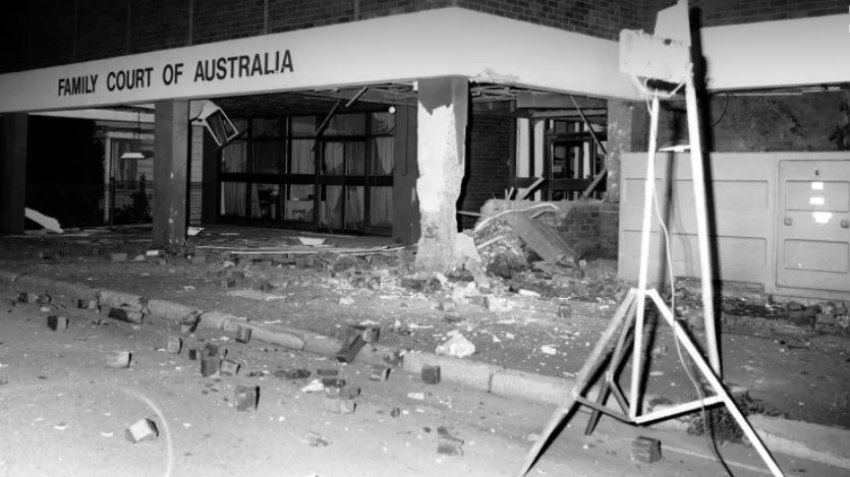
Leonard John Warwick, known as the “Family Court Bomber”, was finally found guilty of murder and bombings and sentenced by the NSW Supreme Court on September 3, after 40 years. He received three life sentences without parole.
The 73-year-old was arrested by police on July 2, 2015, appearing before Justice Peter Garling in the NSW Supreme Court in early May 2018, in a trial that was scheduled to last six months. It dragged on for 2 years and he was convicted on July 23.
Warwick was charged with 24 offences including: the murder of a judge and another’s wife; the bombing of a Jehovah’s Witness prayer hall in which the speaker was killed and members of the congregation were injured; the shooting his wife’s brother; and carrying out bombings of court premises, judges’ homes, cars and other venues between 1980-1985.
All these crimes were connected to his efforts in the Family Court of Australia to win control of his daughter and the family home, which started 40 years ago.
Warwick changed his method of murder from shooting to bombing possibly because it would limit potential witnesses. His father had been a coal miner in Helensburg, south of Sydney, who was experienced in bomb-making.
Warwick was found guilty of all charges (except the shooting murder of his brother-in-law) and sentenced for three murders: Family Court Justice David Louis Opas, who was shot dead in June 1980 at his family home; Pearl Watson, who was killed in a bomb blast in July 1984 as her husband Judge Ray Watson was about to leave for work; and the bombing death of Jehovah’s Witness Speaker Graham Wykes in July 1985.
For the March 1984 bombing of Justice Richard Gee and his children, who survived, Warwick was given a 25-year jail sentence. Ten years jail was handed down for his bombing of the Parramatta Family Court in April 1984.
In addition, he received another 15 years for planting a bomb in the car of someone who had moved into the former residence of lawyer Gary Watts, who had acted for Warwick’s ex-wife Andrea Blanchard.
For his bombing of the Jehovah’s Witness Hall, and the injuries sustained by worshippers including children, he received another 25 year's jail.
Clearly, for this man, anyone who gave aid to his former wife and child, as the Jehovah Witnesses had done, deserved to be punished.
Andrea Blanchard alleged that soon after her marriage to Warwick in October 1974, he became violent and kept her isolated from her family, without keys to her home and without the means to learn to drive.
When she stayed with her father and brother, Warwick broke in demanding to see her. She only returned home on the proviso that she could still see her family, and he would stop assaulting her. But after a few months, the abuse and violence resumed. She left him in 1979.
Why did it take 40 years for such appalling crimes to be dealt with?
To some degree, this relates to the question of evidential proof. If you shoot people as your preferred method of murder, you are more likely to be observed. But if you bomb them, after observing their patterns and ensuring the location will not have witnesses, the attack can destroy evidence of your complicity.
The development of more effective forensic testing of evidence over time helped in this case.
However, the trial rested on critical evidence from Warwick’s break-in and bombing of the Jehovah’s Witness Hall. Warwick’s blood was found when he broke a window a week before returning to plant the bomb.
Why did he target the Family Court?
One can only assume because it was one of the reforms introduced under the Gough Whitlam government’s Family Law Act 1975 which set out the framework for the dissolution of marriage — a no-fault divorce based only on the grounds that the marriage had broken down.
The Family Court was established in 1975, with Elizabeth Evatt, the first female deputy president of the Commonwealth Conciliation and Arbitration Commission, invited to be its first chief justice.
At the time, there was a great deal of opposition to the court, especially from the Roman Catholic and Protestant hierarchies, who defended the family as a private institution reinforcing the authority of a man as its head.
When the Whitlam government was elected in 1972, it began reforming women’s legal rights to take on board social equality, which lagged behind.
Consider marriage at the time. The male head of the household “gave” the bride away, and her male husband-to-be “accepted” her. Women could not get access to effective contraception unless the marriage service was already booked, while men always had access to condoms, and rape in marriage was not recognised under the law.
The Family Court was the second federal system to join the Federal Court of Australia. The no-fault divorce was very different from the preceding punitive male-dominated divorce legal framework. When there were no disputed issues in parenting, such as financial support, property distribution or arrangement for the children, the court really played no active role.
But when such items were contested, the Family Court prioritised the best outcome for children, especially in situations of serious physical violence against children and their mothers.
It is interesting to note that Pearl Watson, who was killed by one of Warwick’s bombs in July 1984, worked for 7 years as a counsellor within the Family Court system.
The Family Court today is very different to when it was established by Whitlam and presided over by Evatt. Successive governments have decreased funding, pushed to change its make-up and privatised its internal counselling and mediation facilities.
There are also ongoing attempts to fold the court into a new entity and phase out the specialised family court division. According to former Chief Justice of the Family Court Alistair Nicholson, this would be dangerous, leaving decisions to ill-experienced judges.